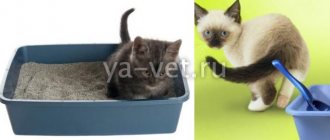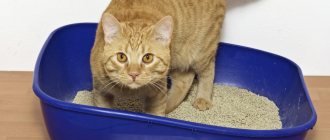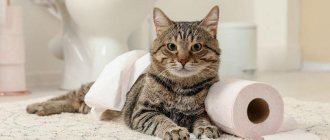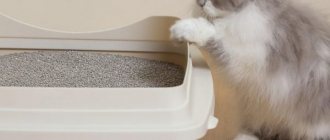It happens that owners of pets pay attention to the fact that the cat cannot pee . What to do at home and what help to provide to your pet? To solve the problem, you should pay attention to the cat’s behavior, since it is this that can indicate the presence or absence of a certain disease.
First of all, it is important to make sure that the cat really cannot pee, and then make any attempts to help. For adult animals over the age of one year, the norm for eliminating minor needs is 1-2 times a day. In some cases, the frequency of urination can be once every two days, which is caused by insufficient activity of the cat or the nervous stress he has suffered. This also includes a sudden change in diet. If urinary retention continues longer than the specified period, most likely the animal has some kind of disease.
One of the most common and serious reasons that a cat cannot pee is urolithiasis , which involves the formation of solid particles of salt or sand in the urinary tract. Subsequently, the patency of the urinary tract becomes difficult and over time may be completely disrupted. In such situations, urgent medical intervention is required, since the mortality rate is very high. At the moment, operations for urolithiasis in cats have an established process and, with timely consultation with a doctor, are successful.
Another common cause of urinary retention is cystitis, an inflammation of the bladder. Most often, a sign of illness is scanty urine output when the animal tries to go to the toilet. Cats and cats experience severe pain, can utter heart-rending screams, and over time completely stop going to the litter box. Similar to the previous case, urgent veterinary assistance is required here.
Various kidney diseases also cause urinary problems. In some cases, problems with the genitourinary system occur in animals from birth, in others they develop at an early or older age. Also, internal diseases in some cases occur in castrated cats if the corresponding operation was previously carried out with violations. One way or another, it is important not to stop observing the animal’s behavior and promptly notice changes associated with the toilet.
Danger of difficulty urinating
It doesn’t matter what exactly is the reason for the appearance of such a problem in a cat, you must always remember that emptying the bladder is a natural process. If suddenly he cannot go to the toilet for a long time , then the body will begin to be poisoned by the breakdown products of urine. All this will lead to sad consequences and severe torment for the cat. This problem will not go away on its own, so you should definitely consult a doctor.
By the way, some symptoms indicate problems with the genitourinary system:
- Bloating in a cat;
- Blood in the urine;
- Too many frequent trips to the toilet.
How to understand that a cat cannot go small
The owner should pay attention to the following changes in the pet’s behavior:
- the cat often visits the litter box, sits for a long time, fusses, but fails to empty itself;
- before and during urination the animal screams in pain;
- regularly licks the genitals, meows pitifully;
- pus, blood, mucus are found in the urine;
- urine darkens and becomes foul-smelling;
- the cat is depressed, hyperthermia, thirst or, conversely, refusal to drink develops;
- the animal stops playing, becomes irritated, breaks out of hands, screams, scratches;
- the stomach is swollen, touching it is accompanied by a strong pain reaction.
Causes of problems with bowel movements in cats
If you find that your beloved cat does not go to the litter box to pee for a long time, it is necessary to determine the reasons for this strange behavior. The nature of such difficulties is also : there is too little urine in the tray or there is none at all. These symptoms should be reported to a specialist when examining your cat. Most often, she cannot go to the toilet due to various illnesses.
Urolithiasis disease
With this disease, salt or sand appears in the excretory canals, which affects the bladder. Subsequently, the pet cannot go to bed. The most dangerous thing is when the passage is completely clogged with foreign bodies. All this can lead to rupture of internal organs , resulting in bleeding and death of the cat. Well-fed cats that lead a sedentary lifestyle are especially susceptible to the formation of urolithiasis.
Kidney diseases
When this organ does not function properly and does not process fluid well, difficulties arise in emptying the bladder.
Cystitis
As a rule, with the standard course of this disease, the cat simply pees often. But since their urethral canal has a special structure, urination may completely disappear. When hypothermia occurs, the excretory tracts in cats become swollen and inflamed, causing their capacity to deteriorate.
Congenital abnormalities of the excretory tract
Such problems occur in rare cases. Moreover, signs of the disease can appear in a domestic cat only in adulthood .
Overexcitement in uncastrated animals
Sometimes increased arousal leads to difficulty urinating. In this condition, pets may experience enlargement of the gonads , leading to blockage of the urethra. Sometimes a plug of discharge appears in the urethral canal due to overstimulation.
In addition, a lack of water in a cat’s diet can contribute to problems with urination.
Why is cystitis dangerous?
thickening of the walls of the bladder with chronic cystitis.
Cystitis can be acute or chronic . Without measures, acute cystitis becomes chronic, which is difficult to treat. Chronic cystitis is more common in older animals, and its main symptom is the presence of blood in the bladder. With chronic cystitis, changes occur in the walls of the bladder, hypertrophy of the muscle layer develops, that is, the bladder does not empty completely. As a result, an infection accumulates, which manifests itself as another attack of cystitis.
In advanced cases, cystitis is complicated by the development of purulent processes. Inflammation from the bladder rises to the kidneys, causing their disease (pyelitis), provokes the formation of salt stones, and the development of paresis or paralysis of the bladder. In severe cases, the inflammatory process spreads into the abdominal cavity, causing peritonitis.
With obstruction (blockage) of the urethra, internal pressure in the bladder, ureter and renal pelvis increases, this leads to kidney blockage - a complete cessation of urine output. The animal's condition quickly deteriorates due to the development of intoxication (lethargy, apathy, vomiting and a specific smell of exhaled air). Part of the function of the kidneys in removing toxic products can be taken over by the skin, lungs, and digestive organs - in this way the body tries to reduce the concentration of toxins and save life. Without emergency veterinary care, urethral obstruction in cats can be fatal within 24-48 hours.
The main signs of the disease
A cat with such ailments begins to fuss, behave very strangely, and meow. In addition, he will constantly spin around the tray, and when going to the toilet, the pet will press against the edge of the box to help the bladder empty. If a cat has problems urinating normally , it will experience a burning sensation and pain. However, only a specialist can find out what caused the painful bowel movement.
There is an opinion that cats sterilized in childhood are the most susceptible to urolithiasis. Moreover, if the pet still has kidney problems , then he may have no urge to urinate at all. In some situations, it is difficult even for veterinarians to determine the early symptoms of the formation of stones or animal sand in the kidneys.
Treatment of cystitis
When the first signs of cystitis appear, you should provide the animal with peace and warmth; you can warm the stomach with a heating pad. It is necessary (!) to remove food from the cat, which will help stop the increase in urine concentration and reduce the load on the kidneys to eliminate metabolic products. It is also important to increase the amount you drink, as the liquid “flushes” the bladder. For cystitis, diuretics are also very useful - decoctions of lingonberry leaves, half-palm, etc. (only if there is no blockage of the urinary canal!)
Treatment is prescribed by a veterinarian depending on the complexity of the disease. For acute bacterial cystitis, long-term antibiotics are prescribed. In severe cases, it is possible to wash the bladder with a solution of potassium permanganate, furatsilin, etc. Usually, for cystitis, diuretics, homeopathy (Kantaren), Cat Erwin, vitamins and immunocorrectors are prescribed. If urination is painful, painkillers may be prescribed, and if infectious complications occur, sulfa drugs used to treat urinary tract infections.
If cystitis in a cat is a consequence of another disease of the genitourinary system, then this disease should be treated first.
In any case, you should not self-medicate cystitis; this can harm the animal.
After treatment, a repeat urine test is necessary to ensure there is no infection.
Self-diagnosis
When there are suspicions of problems with the urinary system in a beloved pet, first aid should be provided. If the cat has stopped going to the toilet in a small way, and there is no opportunity to visit a veterinary clinic, then you should examine the animal yourself to find out the degree of fullness of the bladder . To do this, the furry pet must be placed on its paws and clasped with both hands. Then you should carefully palpate the bladder on a line that is perpendicular to the testes. If the cat is severely inflamed, he will not allow this to be done; you need to urgently take him to the clinic.
If you were able to examine the bubble, then estimate its size and note how dense it is. In its normal state, this organ is the size of a nut and soft to the touch. An enlarged and hard bladder indicates serious problems, so you should not waste precious time; it is better to show the animal to a doctor. To alleviate the condition of your furry pet, you can also place a heating pad on the stomach and perineum.
When is infrequent urination normal?
If the kitten is still small, only 5-6 weeks old, then it is considered normal if he pees once every 1 - 1.5 days. This is exactly the period when the baby weans his mother’s milk and smoothly switches to adult food, learns to go to his place (in the tray).
By 2-3 months, the cat’s genitourinary system has finally developed, the amount of food and drink increases, and therefore the frequency of visits to the toilet. By this age, a healthy pet already pees 1-2 times a day.
Of course, this is all individual and depends on how much water the animal drinks and how active it is. But in general, these indicators are approximately the same. And if the pet is already a year old or more, his urination has ceased to be stable at the age norm of 2-3 times a day, and on the second or third day after the start of difficulties with trying to pee, nothing has changed for the better - it’s time to sound the alarm.
How to help a cat if he can’t go to the toilet?
Never massage your cat's belly when this disease occurs, as this will only make the situation worse. In the clinic, first aid involves installing a catheter to drain fluid from the body. This procedure is very painful and can only be performed by a qualified doctor. Sometimes such an operation is performed under general anesthesia.
During catheterization, antiseptics are used to flush the bladder. It is prohibited to carry out this procedure too often, as it also leads to swelling of the urinary tract. The doctor will find out the cause of difficulty urinating and prescribe appropriate treatment.
Usually cats are given painkillers and herbal infusions. Rose hips, lavender, plantain, horsetail and lingonberries help well with such problems. Sometimes a hot bath helps : the pet is immersed in water up to the heart area for 10 minutes. They also prescribe, if it is impossible to go and pee, boiled pumpkin and a dessert spoon of strawberry juice.
Anti-inflammatory drugs are prescribed for all kinds of inflammation. Even after the results appear, you must continue to take them. must be included in your pet’s diet , and in the spring you can give him nettle . In addition, the cat is prescribed active games and frequent walks. Most diseases of the urinary system are chronic, so it is advisable to take herbs for a long time and repeat the course of treatment constantly.
Kidney collection perfectly helps to remove sand from the body. It is sold in any pharmacy, but it is better to consult a specialist. You can constantly give your cat a decoction of black currants, parsley, birch leaves and bearberry. You should treat this way for at least a month.
What can be done to alleviate the pet's condition?
Of course, when a cat cannot urinate, it is necessary to urgently take him to the veterinarian, but if this is not possible, then you can put a heating pad on the pet’s perineum and stomach.
Under no circumstances should you massage your cat’s tummy; these actions can only worsen your pet’s condition.
First and urgent aid is to insert a catheter to drain urine. This is a difficult and rather painful procedure and should only be carried out by a qualified specialist, and there are often cases of placing a catheter under general anesthesia. During catheterization, the bladder is washed with antiseptics. Frequent catheterization should not be performed because this procedure leads to swelling of the urinary tract, and as a result, the cat will not be able to urinate. Next, the veterinarian will determine the cause of this condition and prescribe treatment.
Diagnostics
After emergency measures are taken, the cat must undergo the necessary diagnostic procedures to identify an accurate diagnosis and prescribe the necessary treatment. Typically, a urine test is taken from the animal and an ultrasound scan of the abdominal organs, kidneys and bladder is performed.
Diet for difficulty urinating
For an animal that is susceptible to urolithiasis, it is necessary to create a corrective diet. His diet should be rich in glutamic acid and vitamins A, B 6. The following products should be excluded from the feed:
- Pork, since it is a very fatty meat that leads to thickening of urine;
- You should not give milk, as it contains a lot of magnesium, which will further impede the flow of urine;
- It is forbidden to add salt to food;
- Raw meat is also not recommended;
- Fish should be discarded, because the phosphorus contained in it is deposited by the excess mineral in the bladder, leading to the appearance of stones.
In general, it is better to give such an animal a balanced food specially designed for cats with similar problems.
First aid
In a situation where a cat cannot pee, what should you do at home? First, it’s worth checking whether anything has changed in the cat’s life:
- castration;
- moving;
- change of owners;
- change of feed;
- low activity after illness;
- drug treatment;
- other surgical interventions.
If none of this has happened in the cat’s life, and the behavior is very different from usual, it is important to help him.
First aid
First aid:
- Place a warm heating pad or compress on your stomach and perineal area. Make sure that the cloth or heating pad is not too hot. It is necessary to warm, but not burn the abdominal cavity;
- place the animal in a bath or basin at a comfortable temperature. It is necessary to ensure that the water does not reach the heart area;
- control the volume drunk. The animal must drink a lot. If it refuses, it is allowed to pour in a little from a pipette.
A good way to help him cope with his illness is to play with him if he is active. But you shouldn’t force your cat to do this, especially if it’s hard for him.











